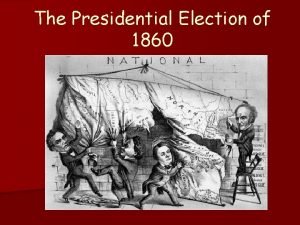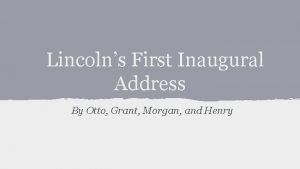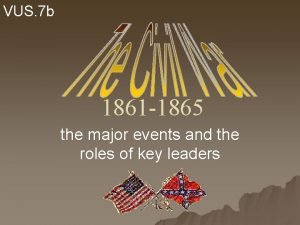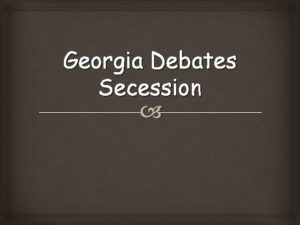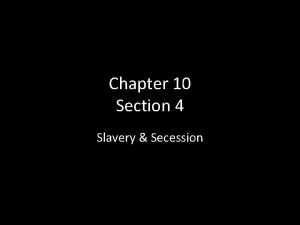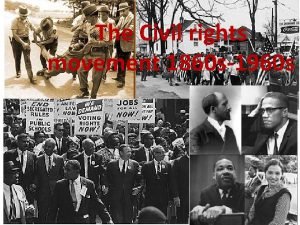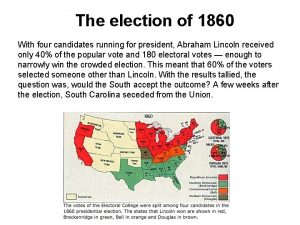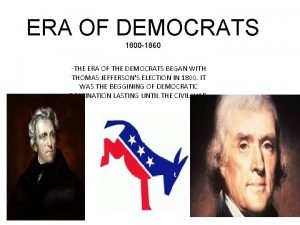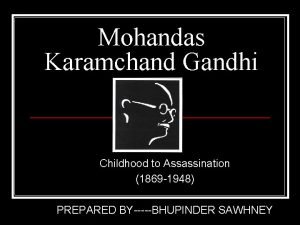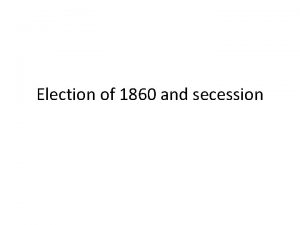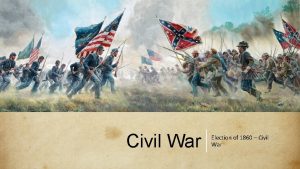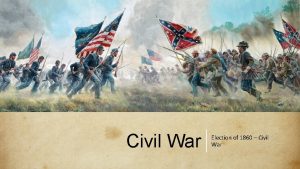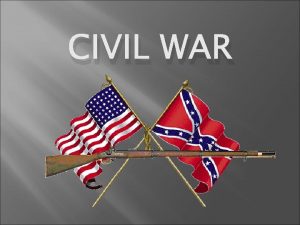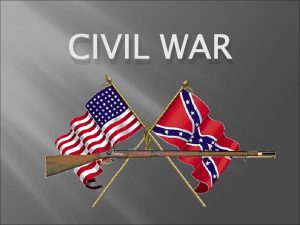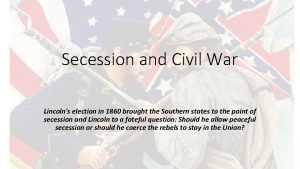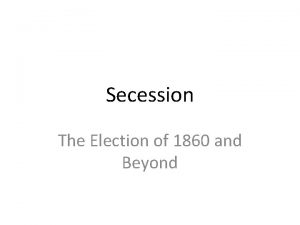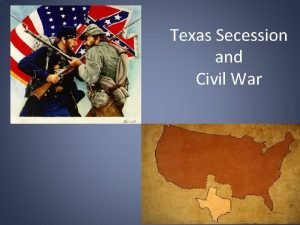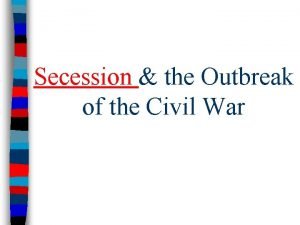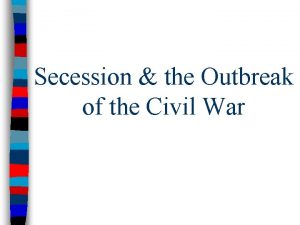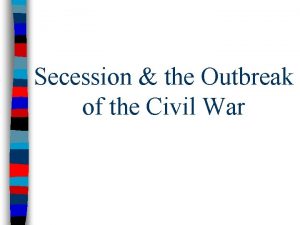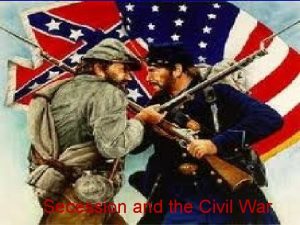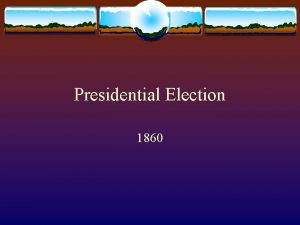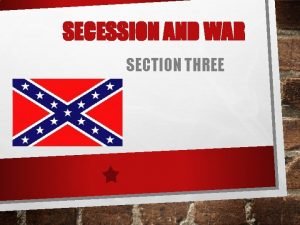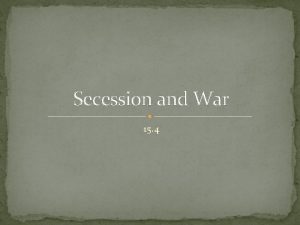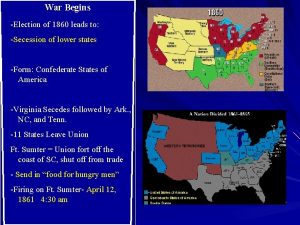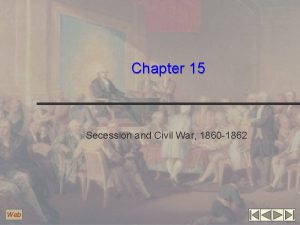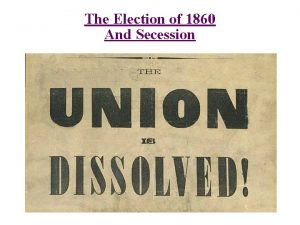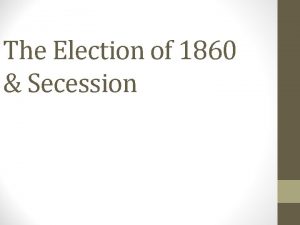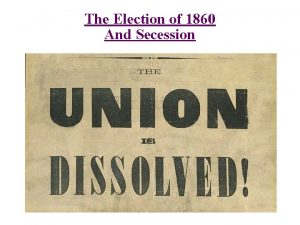The Civil War Secession Movement Election of 1860



























- Slides: 27

The Civil War

Secession Movement �Election of 1860 �Democratic fear of “Black Republicans” • Fear of interference in states • Fear of forced miscegenation and slavery of white men �Secession a “Constitutional” right • Compact theory of federal union (recall VA/KY resolutions and SC Nullification)

Gospel of Disunion � � Commissioners sent to each slave state to convince state legislatures or secession conventions to secede. John Preston in 1861: “The conflict between slavery and non-slavery is a conflict for life and death” and “The South cannot exist without African slavery” Jabez Curry in 1861: secession meant “deliverance from Abolition domination” and slavery would be “assaulted, humbled, dwarfed, degraded, and finally crushed out. ” Alexander Stephens in 1861: The prevailing ideas entertained by. . . most of the leading statesmen at the time of the formation of the old Constitution was that the enslavement of the African was in violation of the laws of nature; that it was wrong in principle, socially, morally, and politically. It was an evil they knew not well how to deal with, but the general opinion of the men of that day was that somehow or other, in the order of Providence, the institution would be evanescent and pass away. . Our new government is founded upon exactly the opposite idea; its foundations are laid, its cornerstone rests upon the great truth that the Negro is not equal to the white man; that slavery--subordination to the superior race--is his natural and normal condition.


Gospel of Disunion – after the War � John Preston in 1868: The North “defeated the promised destiny of America” and “Liberty may be dead but the Union is preserved” � Jabez Curry in 1901: “The object in quitting the Union was not to destroy, but to save the principles of the Constitution. ”

Secession Crisis Timing of Secession Percentage Percent Slaves of White in Population Families Owning Slaves Initial states to secede South Carolina 57 47 Georgia 48 38 Florida Alabama Mississippi Louisiana Texas States seceding later Virginia North Carolina Tennessee Arkansas Remained in Union Delaware Maryland Kentucky Missouri 44 45 55 47 30 35 35 49 31 29 31 33 25 28 27 29 25 20 2 13 20 10 4 15 24 13

Secession Crisis

Confederate States of America � March 4, 1861 � President Jefferson Davis � Constitutional protection of slavery � Superiority of white race � “state’s rights” causes similar problems to the Articles of Confederation � Buchanan does nothing when states secede.

First shots Federal troops moved to Fort Sumter � Davis orders fire and Lincoln enlists Army � Virginia, Tennessee, North Carolina, and Arkansas join Confederacy � Border States remain � Lincoln’s goal is to preserve the Union �

North’s Three Prong Strategy �“Anaconda” • Pressure Virginia • Blockade South • Split Confederacy

Balance Sheet of the War



Problems in the Confederacy �Attempts to centralize �Over 100, 000 deserters • Secret Union societies in N. Arkansas, E. Tennessee, etc. �Economic and political problems • Chapter 4: 32: 25 – 38: 50


“A Rich Man’s War and a Poor Man’s Fight” Union • Mandatory enrollment (2045) • “commutation fee” • Irish Immigrants Confederacy • Draft (18 -35, 45, 50) • “twenty-negro provision” Chapter 2: 28: 04 – 32: 02, 54: 32 – 57: 51


Modern warfare � Episode 2: 44: 22 – 46: 50

Turning Points of the War � 1. Emancipation Proclamation • Caused by enslaved people freeing themselves • Only affected slaves in territories under Confederate control • arguably did not free any enslaved peoples • Gave the Union numerous advantages • Changed the goal and purpose of the war � 2. Battle of Vicksburg � 3. Sherman’s March to the Sea � 4. Lincoln’s re-election in 1864

Impact of the War

Blacks in the War � Chapter 5: 1: 05: 20 – 1: 14: 00 � 200, 000 serve in Union military � 20 congressional medals of honor � Justification for equality � Navy: equal, Army: segregated � Inequality in pay and rank � Union Captain - "A great many [white people], " he wrote, "have the idea that the entire Negro race are vastly their inferiors. A few weeks of calm unprejudiced life here would disabuse them, I think. I have a more elevated opinion of their abilities than I ever had before. I know that many of them are vastly the superiors of those. . . who would condemn them to a life of brutal degradation. "

Total War �All levels affected �Depersonalization

Civil Liberties during civil war �Spies: Chapter 7: 19: 25 – 22: 33 �Draft �Free speech issues �Use of Military tribunals and detention �Habeas corpus

Effects of the Civil War Politics �Lack of Southerners allows North to get things done • • • Homestead Act Transcontinental Railroad Protective Tariff Land Grant Colleges Federal encouragement of immigration

Effect of the war on Women � Chapter 5: 52: 28 – 56: 30 �Nursing and US Sanitary Commission �Charity organizations �Southern women forced to run plantations �Largely return to pre-war status at the conclusion of the war �Invigorates desire for suffrage

Effect of war on Government � Expansion of federal government � New financial system and economic prosperity � Sets the stage for Radical Reconstruction � Forever ends ideas of nullification, secession, and states rights � Supremacy of federal government confirmed

The Legacy of the Civil War �David Blight and the Lost Cause narrative • 33: 40 – 40: 30, 42: 35 – 45: 45
 Chapter 16 lesson 2 challenges to slavery
Chapter 16 lesson 2 challenges to slavery Definition
Definition John breckinridge opinion on slavery
John breckinridge opinion on slavery Civil war first modern war
Civil war first modern war Why were threats of secession feared
Why were threats of secession feared Vus 7a what event sparked secession of the southern states?
Vus 7a what event sparked secession of the southern states? Debate over secession in georgia
Debate over secession in georgia Chapter 10 section 4 slavery and secession
Chapter 10 section 4 slavery and secession Civil rights webquest
Civil rights webquest 1860
1860 Aspirateur daniel hess
Aspirateur daniel hess American reform movements between 1820 and 1860
American reform movements between 1820 and 1860 W.w. norton
W.w. norton Decreto 1860 de 1994
Decreto 1860 de 1994 American romanticism 1800 to 1860 worksheet answers
American romanticism 1800 to 1860 worksheet answers American romantic period
American romantic period South africa 1860
South africa 1860 American romanticism 1800 to 1860 worksheet answers
American romanticism 1800 to 1860 worksheet answers Rationalism vs romanticism
Rationalism vs romanticism Arthur and lewis tappan apush
Arthur and lewis tappan apush South carolina 1860
South carolina 1860 Border states in 1860
Border states in 1860 Map of 1860
Map of 1860 Era of the democrats 1800-1860
Era of the democrats 1800-1860 Program of civil disobedience movement
Program of civil disobedience movement Civil rights movement vocabulary
Civil rights movement vocabulary Civil rights movement essential questions
Civil rights movement essential questions Civil rights movement jeopardy
Civil rights movement jeopardy

